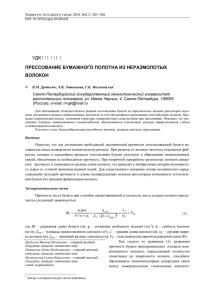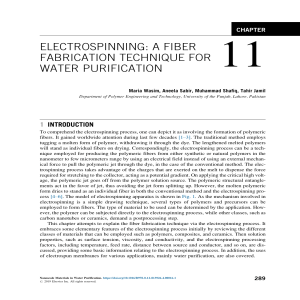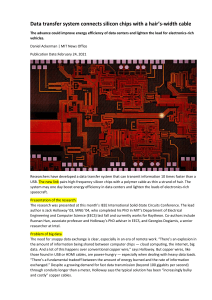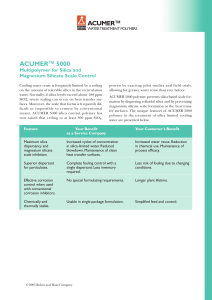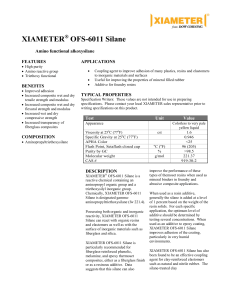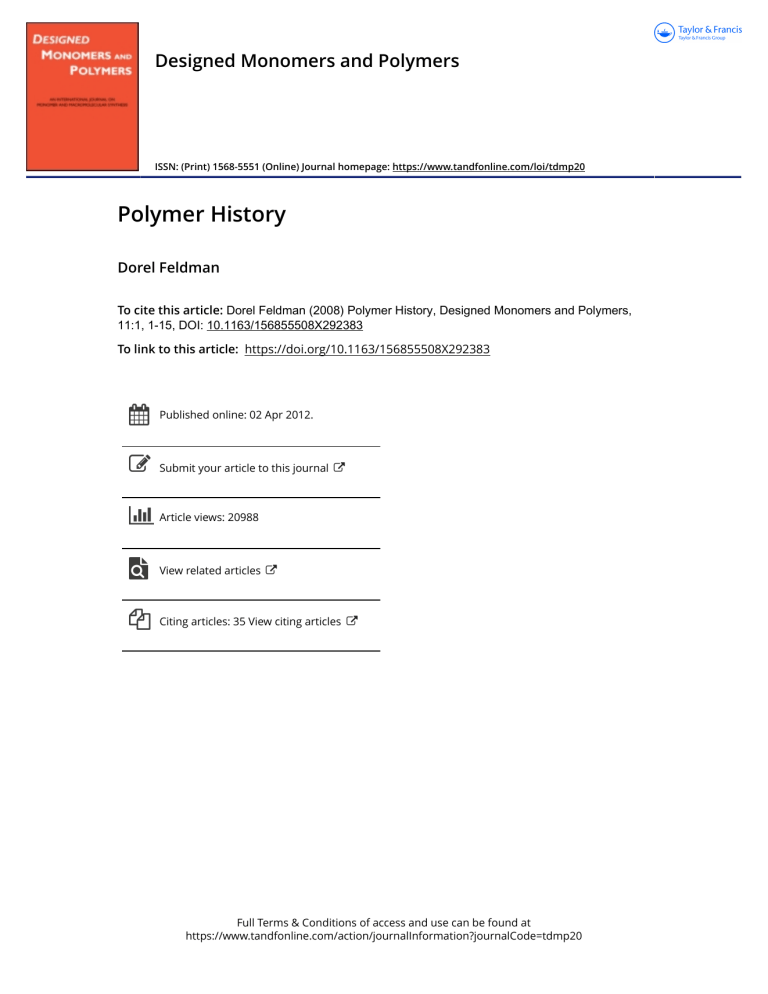
Designed Monomers and Polymers ISSN: (Print) 1568-5551 (Online) Journal homepage: https://www.tandfonline.com/loi/tdmp20 Polymer History Dorel Feldman To cite this article: Dorel Feldman (2008) Polymer History, Designed Monomers and Polymers, 11:1, 1-15, DOI: 10.1163/156855508X292383 To link to this article: https://doi.org/10.1163/156855508X292383 Published online: 02 Apr 2012. Submit your article to this journal Article views: 20988 View related articles Citing articles: 35 View citing articles Full Terms & Conditions of access and use can be found at https://www.tandfonline.com/action/journalInformation?journalCode=tdmp20 Designed Monomers and Polymers 11 (2008) 1–15 www.brill.nl/dmp Review Polymer History Dorel Feldman ∗ Department of Building, Civil and Environmental Engineering, Concordia University, 1455 De Maisonneuve Blvd.W., Montreal, Quebec, Canada H3G 1M8 Abstract During the last century and a half, new families of engineering materials known as polymers have been discovered and produced, that have not only challenged the classical materials but have also made possible the realization of new products which have contributed to extend the range of activities of mankind. This paper is a brief review of the history of the most important groups of polymeric materials, such as plastics, fibers and elastomers. In the growth of polymeric materials during the last century and a half, plastics are the leader followed by fibers and elastomers. Koninklijke Brill NV, Leiden, 2008 Keywords Polymers, plastics, fibers, rubber, review 1. Introduction Polymers are at the basis of important industrial goods. Their rapid growth in production is caused, beside social factors, by the necessity to replace classical materials. The word “polymer” was introduced by the Swedish chemist J. J. Berzelius. He considered, for example, benzene (C6 H6 ) to be a polymer of ethyne (C2 H2 ). Later this definition underwent a subtle modification [1]. Polymer science is a relatively new discipline which deals with plastics, natural and synthetic fibers, rubbers, coatings, adhesives, sealants, etc.; all of these materials nowadays have become very common. The concept of polymers is one of the great ideas of the 20th century. It emerged in the 1920s amid prolonged controversy and its acceptance is closely associated with the name of H. Staudinger who received the Nobel Prize in 1953. Many examples of synthetic polymers can be mentioned; some everyday, like polyesters or nylons, others less known, like the ones used for medical applications for organs, degradable sutures, etc. * Tel.: (1-514) 848-2424, ext. 3202; Fax: (1-514) 848-7965; e-mail: feldman@bcee.concordia.ca Koninklijke Brill NV, Leiden, 2008 DOI:10.1163/156855508X292383 2 D. Feldman / Designed Monomers and Polymers 11 (2008) 1–15 On the basis of economic and application considerations plastic materials can be divided in commodity (characterized by high volume and low cost) and engineering plastics (higher cost and low volume). In the first group are considered polyethylene (PE), polypropylene (PP), poly(vinyl chloride) (PVC) and in the second polycarbonate (PC), poly(etheretherketone) (PEEK), polyimide (PI), etc. Fibers, natural, artificial (modified natural) and synthetic, are characterized by high aspect ratio, high strength and modulus and other properties depending on their applications. Elastomers exhibit the ability to stretch and retract rapidly. 2. Plastics The first plastic material was based on nitrocellulose and was obtained by Parkes in 1862 and Hyatt in 1866. The addition of camphor to nitrocellulose led to the first thermoplastic (a modified natural polymer) known as celluloid. By 1900 this material was used for movie film. In about 1897, galalith (gala = milk, lithos = stone) was produced in Germany by reacting casein (a milk protein), with formaldehyde [2]. The first synthetic thermoset polymer (a phenol-formaldehyde (PF)), known as Bakelite, was obtained in 1907 by Baekeland through the polycondensation of phenol with formaldehyde. Bakelite was commercialized in 1909–1910 [3]. The commercial development of this PF material is considered to be the beginning of the truly synthetic plastic era and of the plastic industry, although cellulose nitrate (semi-synthetic) had been known and in use for some time. The successful use of PF resin catalyzed the development of other polycondensation products based on formaldehyde (F) with urea (U) and melamine (M), known as amino resins, aminoplasts or aminoplastics. Such polymers were first described by Tollens in 1884 and were patented by John in 1918 [4]. Aminoplasts, contrary to phenoplasts, can be made translucent or in light colors [5]. In 1926 Rossiter produced aminoplasts based on formaldehyde and mixture of urea and thiourea [6]. The production of MF resins began in the mid-1930s [7]. Unsaturated polyesters (uPES) were discovered in 1933 by Ellis and commercialized around 1942. These polycondensation products are known as alkyds, name which appears to have been derived from alcohol (alk) and acid (yd); they are used primarily as coatings. From the same family, glycerophthalic (Glyptal) coatings involve glycerol and phthalic anhydride [5]. The existence of vinyl chloride (VC) was reported by Liebeg and Regnault in 1835, but its ability to polymerize was not fully known at that time. The effect of sunlight on VC was later investigated by Baumann in 1878, when it was observed that a white substance formed as a result. Very little progress was then made until 1912–1916 when Klatte discovered the basis for VC photo-polymerization [8]. In 1926 Ostramislenski patented flexible film cast from a solution containing PVC and a plasticizer [4]. Also it was discovered that PVC became a flexible material that re- D. Feldman / Designed Monomers and Polymers 11 (2008) 1–15 3 sembled rubber or leather when it was heated in the presence of a high-boiling-point liquid. This led to the use of phthalate esters as plasticizers for PVC. The industrial production of PVC using emulsion and suspension technologies had occurred by the start of WW II. During the war, the acute shortage of rubber accelerated developments in this area, particularly in electrical cable insulation and sheathing [8]. After the war developments were concerned largely with plasticized PVC, handled mainly by extrusion, calendaring and paste techniques (plastisols). The high-pressure polymerization of ethylene was accidentally discovered in 1933 by Gibson and Fawcett. A small-scale operation in 1937 was followed by the first commercial production in 1939 [6]. Styrene (S) was obtained by Bonastre in 1831 by distillation of storax balsam; it was also examined by Simon in 1839, who observed that after storage for several months the liquid became a solid (which he wrongly supposed to be an oxide). In 1845, by heating S, Blyth and Hofmann obtained, even in the absence of oxygen, a similar solid which they termed metastyrene. Practical uses of polystyrene (PS) were considered by Kronstein (1902) and Matthews (1911); the last one described the thermal and catalytic styrene polymerization to yield a substance able to replace celluloid, glass and hard rubber [9]. The problem of preventing premature polymerization of S impeded development until Dufraise and Moreau used inhibitors in 1922. Contributions to the study of S polymerization are due to Ostromislenskii (1911–1925) and Staudinger (1929–1935) [9]. Since the 1930s the monomer has been used in co-polymers with elastomeric characteristics [6]. Large-scale commercial development dates from 1935 [11, 12]. High impact grades were produced since 1948 and isotactic PS was obtained by Natta in 1955 [9]. Styrene is used for important co-polymers and terpolymers such as styrene–acrylonitrile (SAN), styrene–divinyl benzene (S-DVB), styrene–maleic anhydride, acrylonitrile–butadiene–styrene (ABS) and others [10]. Polymers based on acrylonitrile, butadiene and styrene were first introduced in the late 1940s. The first patent that claimed a product made of a physical mixture of B-AN elastomer and AN-S co-polymer was issued in 1948. Improvements in polyblending technology and the development of grafting processes during the 1950s led to a significant improvement of ABS terpolymer properties [13]. Poly(methyl methacrylate) (PMMA) is produced, first in 1933, for aircraft glazing and for a variety of applications particularly where transparency and/or good weathering resistance is important [2]. Around 1938 Schlack discovered poly(ε-caprolactam) (polyamide 6, PA-6) known as nylon 6 which was commercialized in 1939. Carothers started polycondensation studies in 1929 and obtained nylon 66 as a fiber-forming polymer in 1935. The production of PA as a plastic started in 1941 [5, 14]. Since then many different polyamides for plastics and fibers were produced. More recently, in 1994, a highperformance PA (Zytel) was commercialized. The development of fluoro-polymers began with the synthesis of poly(tetrafluoro ethylene) (PTFE) in 1938: this was a major leap forward in material science. 4 D. Feldman / Designed Monomers and Polymers 11 (2008) 1–15 Yet the new polymer could not be fabricated by melt processing. The next two forms of PTFE, fine powder and dispersion, were also not melt-processible. The pursuit of more easily processible fluoro-polymer led to fluorinated ethylene– propylene co-polymer (FEP), which could be melted and processed in an extruder. Poly(perfluoroalkoxy) (PFA), which was introduced in 1973, offers both melt processing and high thermostability like PTFE. Some other polymers in this family were discovered, such as poly(chloro-trifluoro ethylene) (PCTFE), poly(vinyl fluoride) (PVF), poly(vinylidene fluoride) and other co-polymers and terpolymers [15]. Saturated polyesters were first studied by Carothers starting 1929; he was able to obtain a PES of propylene glycol and 1,16-hexadecanoic acid with an average MW of 12 × 103 . As the aliphatic PES all had boiling points too low, he turned his attention to polyamides. Later on studies on PES were done by Whinfield and Dickson (1941–1946). The most important polymer in this group is poly(ethylene terephthalate) (PET), produced first in 1955 and used as a plastic, film and fiber. The original discovery leading to the world-wide interest in all classes of polyurethanes (PU) was made by Bayer and his co-workers in 1937 as a competitive response to the work done by Carothers on the polyamides. In 1947 Bayer published an impressive account of the synthesis of PU and polyureas. In the 1950s the basic technology used polyesters to obtain the flexible foams and polyether polyols were introduced in 1957 [16]. Later on, PUs were found to be useful for the production of plastics (1961), elastomers, foams, adhesives, fibers and corrosion-resistant coatings [17, 18]. A new transparent thermoplastic PU was produced recently [19]. In 1909 Prileschajew discovered that olefins would react with peroxy benzoic acid to form epoxides. Peroxy acid epoxidations play an important role in epoxy resin production [20]. Epoxy resins (EP) were first synthesized by Schlack (the inventor of nylon 6), in 1934. Their curing reaction was discovered by Castan and Greenlee (late in the 1930s) and polymer products were introduced in the market towards the end of World War II. Although a number of different types are now commercially available, the major share of the market is still held by systems based upon the reaction products of epychlorohydrin and bisphenol A [7, 21, 22]. Vinyl ester resins, which may be regarded as hybrids of epoxy and polyester resin chemistry, were developed in the 1960s. They are made by reacting epoxy resins with ethylenically unsaturated carboxylic acid in order to give terminal unsaturation [7]. In the early 1950s, Hogan and Bank discovered that ethylene can be polymerized under moderate conditions (3–4 MPa and 70–100◦ C) with chromium oxide catalysts on silica support. Manufacture of high-density PE (HDPE) produced by this procedure started in 1956. Currently HDPE is one of the largest commodity plastic [23]. Shortly after (1953) Ziegler and Natta independently developed a family of stereospecific transition-metal catalyst that led also beside HDPE to the synthesis and commercialization in 1957 of polypropylene (PP) as a major commodity plastic [8, 24–26]. D. Feldman / Designed Monomers and Polymers 11 (2008) 1–15 5 In 1898 Einhorn reported the formation of polycarbonates (PC) in the reaction of phosgene with dihydric phenols. In 1902 Bishoff and Hedenstrom confirmed this work using an ester-exchange reaction. These PCs were intractable, insoluble materials, and for many years the plastics industry showed no interest in their development, though admittedly Carothers included aliphatic polycarbonates in his work on polyesters and reported on these in 1930. That same year Carothers and Natta prepared a number of aliphatic PCs. When bisphenol A was readily available commercially due to contributions made by Schnell (1956), the time was opportune for the development of bisphenol A polycarbonates. Such polymers became available for assessment in 1958 and the full-scale production commenced in 1959 in Germany and 1960 in the USA [11, 27, 28]. In the same period, SAN co-polymer (1954) and polyacetals (1956) were synthesized for the first time. Ionomers were first prepared in 1964 by co-polymerization of ethylene with a small amount of an unsaturated carboxylic acid (acrylic or methacrylic acid), using a high-pressure process. They have the characteristics of thermoplastic and thermosetting polymers. The commercial grades available in 1970s used either zinc or sodium as the cross-linking ion [11]. An important class of ionomers are perfluoro sulfonate ionomers (PFSI), which are co-polymers of tetrafluoroethylene and a perfluorinated vinyl ether containing a terminal sulfonil fluoride group (SO2 F) [29]. Polyimide (PI) resins, primarily of the thermosetting type, were developed after 1953 and became commercially available around 1963. The thermoplastic PI result from the polyaddition of bismaleinimides and HZ-R-ZH compounds, where HZ may be diamine, disulfide dialdoxim, etc. Although aromatic PI retain usable properties at 300◦ C for months and withstand exposures of a few minutes well over 500◦ C, their applications have been limited [30]. Polyamide imide was introduced around 1976 and polyether imide around 1982 [2, 5]. Flory suggested in 1956 that polymers containing long rigid (rod-like) units could form anisotropic ordered solutions above some minimum concentration depending upon temperature and the length/diameter ratio. Later on in 1974, liquidcrystal behavior for a polymeric system was first observed in a concentrated solution of poly(benzyl L-glutamate) which forms a rod like α-helical conformation in a variety of organic solvents. Liquid crystal polyesters may have been recognized as early as 1965; they have highly aromatic structures. Aromatic polyamides (aramid) form a nematic state, in which there is a parallel but not a lateral order [29]. Polysulfone was introduced around 1965. Polyarylsulfones were commercialized in the period 1967–1976 and polyethersulfone around 1972. All polysulfones are transparent, light yellow to amber polymers. Their high heat distortion temperatures are only surpassed by aramides, polyimides and polyamideimides [2, 5]. In 1976 Kaminsky and Sinn discovered a new family of catalysts (a metallocene complex) for ethylene polymerization. Kaminsky–Sinn catalysts and a variety of their modifications afforded the synthesis of ethylene-α olefin co-polymers with a high degree of compositional uniformity [23]. 6 D. Feldman / Designed Monomers and Polymers 11 (2008) 1–15 PEEK, the most important member of the poly(aryl ether ketone)s (PAEK), has become commercially available in 1978. After 1980 continuous growth was recorded with the development of a number of high performance polymers that could compete with traditional materials such as polyamide 4-6 (1987), sindiotactic PS (1989) metallocene polyolefins, polyphthalamide (1991), and styrene–ethylene co-polymer and sindiotactic PP in 1992 [31, 32]. 3. Fibers The defining characteristic of a fiber is its thread-like form, without restriction on chemical composition. Fibers can be metallic, mineral or organic. Nearly all nonmetallic fibers are polymeric materials, either natural, artificial (modified natural) or synthetic. Natural fibers such as wool and cotton have aspect ratios in the order of 103 or greater. The organic fibers are carbon or heterochain polymers; the major mineral fibers like glass and asbestos are macromolecular silicates. Organic synthetic fibers are mostly thermoplastic, some are elastomeric and very few are thermosets. Their history covers less than 75 years [33–35]. In the beginning, textile fibers came from nature: animal skins, hair, wool, silk from silkworms, and plants like flax, cotton, hemp, etc. The utility of flax and hemp twines was recognized even in the Stone Age. Flax fabrics were used in pre-dynastic Egypt (fine linen cloth being woven in 3800 BC) and in Neolithic lake dwellings in Switzerland. References to hemp and ramie (fibers cultivated in temperate latitudes, and unknown to ancient Egyptians and Hebrews or to early Greeks) occur in Chinese writings dating 2800 BC and in early Sanskrit literature. Jute appears to have been cultivated in Bengal from the most ancient times. Traditionally the culture of silk began in 2640 BC in China, where for many centuries its origin and the art of manipulating it were kept secret (it did not reach Japan until AD 300). There are Sanskrit records dating from 1000 BC that refer to the working of silk in ancient India. Wool sheep appear to have originated as mountain animals in Mesopotamia. It is well known that their wool was employed for clothing at least 5000 years ago [10]. For centuries, all textiles came from fibers that were harvested from a plant, animal or insect. Then, at the end of the 19th and beginning of the 20th century, people discovered that they could create textile fibers of their own. Those early fibers still originated from a natural source, cellulose from wood pulp, but soon enough, in the 1930s, 1940s and 1950s, a stream of synthetic fibers came on the scene that owed their origin in chemical plants instead of plants that could be grown in the field [36]. The idea for producing artificial fibers seems to have been advanced first by R. Hooke in his Micrographia, published by the Royal Society in 1665. In 1833 Braconnot described the nitration of various celluloses and Liebeg established the D. Feldman / Designed Monomers and Polymers 11 (2008) 1–15 7 tendency of nitrated cellulose to decompose violently when heated. In 1847 Schonbein improved the nitration process by using sulfuric acid as catalyst. The first fibers based on nitrated cellulose were produced by Swan. In 1890 Count Hilaire de Chardonnet obtained so-called “artificial silk” based on this modified cellulose [37]. In 1894 Cross and Bevan discovered that cellulose can be converted by alkali and carbon disulfide to the water-soluble xanthate from which cellulose can be regenerated by various reagents. The new artificial fibers known as “viscose” had two advantages over nitrated cellulose: they did not require (i) denitration and (ii) the use of expensive solvents in their manufacture [37, 38]. Mercerized cotton realized by Mercer in 1844 results from physical modification of cellulose by treatment with a sodium hydroxide aqueous solution [35]. Despaissis patented the cuprammonium process for the production of regenerated cellulose from a solution of cellulose in cuprammonium hydroxide (Schweitzer’s reagent) in 1890 [10]. The commercial viscose (a process that is still in use) was not developed until 1903. The name rayon was accepted by all producers of regenerated cellulose fibers in 1924 [39]. It is interesting to remember that, as early as 1926, Lilienfield prepared viscose rayon filaments with unusually high modulus and high tensile strength. He used highly xanthated cellulose [40]. The commercial cellulose acetate rayon fiber, process based on acetone solutions of secondary cellulose acetate was developed and patented by Miles who partially saponified the triacetate in 1903. In the 19th century researchers reported unusually high molecular weights in the case of some natural products. The ensuing confusion between the colloidal theory and that of macromolecular concepts retarded the progress until Staudinger championed the true macromolecular theory near about 1930. Thus, the beginning of the polymer age was delayed until scientists accepted Staudinger’s theory [1]. Carothers is recognized as the inventor of the first synthetic fiber, known as nylon 66. In 1929 he published his theory of polycondensation and compared it with polyaddition. His initial studies on aliphatic polyesters were done and results were published before discovering the aliphatic polyamide with higher melting point; this one could be spun into a useful apparel fiber suitable for many of the same applications as natural silk. Nylon 66, made from a diamine and diacid, each with six carbons, was commercialized before 1940 and continues to grow in importance today [32]. It is mentioned in the literature [41] that in 1899 Gabriel synthesized polyamide nylon 6. In the 1930s, Schlack repeated this synthesis and produced commercial nylon 6 in 1940 by the polymerization of ε-caprolactam. Like nylon 66, nylon 6 is produced throughout the world and is used both as a fiber and an engineering plastic [42]. 8 D. Feldman / Designed Monomers and Polymers 11 (2008) 1–15 The first polyamide that was mechanically spun from a melt was nylon 9, which had a moderately high melting point of 196◦ C. Considerably work was also done with nylon 5-10 with a melting point of 200◦ C. Nylon 66 decomposes just above its relatively high melting point of 265◦ C [43]. The derivation of nylon 11 from castor oil was developed by Zeltner, Genas and Kastner in 1944, and its production started in 1949 [4]. Nylon 12 first came to the market in Germany in 1959 [44]. Several polyesters were investigated by Carothers during a DuPont program that started in 1929. These polyesters were mostly linear aliphatic and they were characterized by low melting points, considerable solubility in organic solvents and poor resistance to hydrolysis. In 1941 Whinfield and Dickson obtained a aromatic polyester, PET, and found it to have great promise as a fiber- and film-making polymer. Its large-scale manufacture started in 1953 [10, 27, 45, 46]. Hill, Carothers co-worker, also contributed to the preparation of fiber-forming polyesters [47]. Acrylonitrile (AN) was prepared by Moreau in 1893. Poly(acrylo nitrile) (PAN) was developed for fibers in 1940; patents based on the utilization of concentrated aqueous solutions (in Germany) and organic liquids (USA) were obtained in 1942. Pilot production of PAN started in USA in 1943, and the first acrylic fiber (Orlon) was made in 1948 and put into commercial production in 1950. By definition acrylic fibers contain 85% or more AN. Along with PAN was developed a class of fibers known as modacrylic. By definition they are based on co-polymers containing less than 85% but more than 35% AN by weight. Their production started in 1949. Such kind of fibers often contain as co-monomer a high amount of vinyl chloride, vinylidene chloride or vinylidene cyanide [10, 48]. Poly(vinyl alcohol) (PVA) was produced in 1924 by the saponification of poly(vinyl acetate) (PVAc). PVA fibers (Vinylon) were produced in 1951 in Japan by coagulating the extrudate from an aqueous PVA solution in an aqueous sodium sulfate solution. Their insolubilization is done by treatment with formaldehyde [49]. Based on the discovery of heterogeneous stereospecific catalysts by Ziegler, Natta obtained in 1954 crystalline polypropylene (PP). Commercial production of PP fibers and filaments started in 1957. The excellent wear and resistance to staining associated with low cost led to the use of such fibers for various applications [14]. The first aromatic polyamide (aramid) fiber based on poly(m-phenylene isophthalamid) (MPD), known as HT-1 and later re-named, was commercialized under the trade name Nomex by DuPont in 1967. It was also produced in Japan and USSR in 1970. These aromatic polyamides have at least 85% of the amide linkages attached directly to two aromatic rings. In 1973, DuPont started production of another aromatic polyamide fiber, a poly(p-phenylene terephthalamide) marketed as Kevlar; this fiber has exceptional strength competitive with glass, steel and carbon fibers [11, 50]. Aromatic polybenzimidazoles (PBI) were synthesized by Vogel and Marvel in 1961, with anticipation, later justified, that these polymers would have exceptional D. Feldman / Designed Monomers and Polymers 11 (2008) 1–15 9 thermal and oxidative stability. In 1983 PBI fiber, spun from solutions of poly(2,2 (m-phenylene)-5,5 -bibenzimidazole) for a wide range of textile applications, was commercialized [51]. Carbon fibers, first used as light bulb filaments in 1879, trace their modern history back to about 1942. The first commercially produced carbon filament was made from a cellulosic precursor for its application as incandescent lamp filament. Systematic work regarding carbonization of rayon and PAN yarns and fabrics was initially investigated by Union Carbide during World War II. Two processes for manufacturing high-strength and high-modulus carbon fibers from rayon and PAN were invented almost simultaneously in 1959 and 1961. Later, in 1963, a high-modulus fiber made from pitch as precursor was invented. Since 1980, ultra-high-strength fibers from PAN and ultrahigh-modulus fibers from pitch have been developed and are used extensively in the aircraft and spacecraft structures [52–55]. Spandex fibers, which by definition consist of at least 85% of segmented polyurethane, were invented in the 1950s to improve on the process and properties of rubber fibers; they became commercial around 1960 [56]. 4. Elastomers (Rubbers) The first mention of rubber trees is to be found in De Orbe Nuovo by Pietro Martire d’Anghiera, published in latin in 1516. The outstanding source of natural rubber, the large forest tree Heveea Brasiliensis, occurs in the southern equatorial region, mainly in Malaysia, Indonesia, Thailand, Ceylon, India, Cambodia, Vietnam, Brazil, Africa and some other countries from Asia and South America. Such trees were called “Cau-uchu” or “weeping wood” in South-America. The name was derived from the use of the material as an eraser, “rub off pencil marks”, an application introduced by Priestley in 1770. The original name of caoutchouc is still used to denote rubber in many languages other than English, where it is reserved for the rubber hydrocarbon [57, 58]. Until 1823, when Macintosh patented the use of coal tar, the lack of a satisfactory solvent delayed the progress of rubber utilization and the natural rubber remained little more than an academic novelty. In 1839 Goodyear found that heating rubber with sulfur and white lead gave it far superior properties. Hancock exploited this process, termed vulcanization by Brockeden, to provide an elastic material insoluble in common solvent, from the initial thermoplastic one [48]. The so-called cure, namely treatment with sulfur chloride, which is now obsolete, was discovered by Parkes in 1840 [57]. Page reported the results of his studies on natural rubber in 1847. This endeavor may well represent the onset of interdisciplinary research activity involving macromolecules [59]. Faraday showed in 1826 that natural rubber was a hydrocarbon of empirical formulae (C5 H8 ) and Williams gave the name isoprene to the volatile liquid obtained by destructive distillation of natural rubber of composition C5 H8 . A reversing 10 D. Feldman / Designed Monomers and Polymers 11 (2008) 1–15 process done by Bouchardat in 1879 led to a rubbery material. A similar material was obtained by Tilden in 1884 using isoprene from terpentine. The turn of the century led to the development of the automobile and with it the pneumatic tire. The first inflated tire to be commercially successful was based on the invention done by Dunlop (1888–1889) and the first successful cord-tire (a bicycle type tire) was invented by Palmer in 1893. Balloon low pressure tires were first marketed in 1923 and the tubeless tires date from 1951 [57]. The synthesis of an isoprene polymer was first reported in 1875 [61]. In the late 19th century it was already known that conjugated diene hydrocarbons are able to produce elastic items. Indeed in 1881 Hofmann prepared an elastomer from 1,3-pentadiene and Couturier polymerized 2,3-dimethyl-1,3 butadiene in 1892 [60]. At the beginning of 20th century Matthews, Perkin Jr. and Weismann (1909– 1910) studied the polymerization of isoprene. Similar experiments were done by Harries (1911), who produced methyl rubber (poly(2,3-dimethyl butadiene)). The synthesis based on coordination catalysts (Ziegler–Natta type) of an elastomer equivalent to natural rubber was reported in 1954. One year later a polyisoprene based on dispersed lithium catalyst was obtained; both these elastomers had more than 90% cis units [61]. Very active before 1914 in finding new synthetic rubbers were Kondakoff, Butlerov, Ostromislensky and Lebedev, who were making butadiene as early as 1910 and whose work played an important role in the development of the synthetic rubber industry [57]. During World War I two types of methyl rubber were obtained and, because of the rise of the price of natural rubber, the research in view to obtain replacements was intensified. Buna rubber, made by sodium-catalyzed polymerization of butadiene, became available in the late 1920s [60]. One of the most widely used rubbers is the co-polymer of styrene (S) and butadiene (B), known as SBR. In the 1920s the ability of emulsion polymerization in the presence of initiators led to polymers with high molecular weight. The first B-S co-polymer, Buna S was obtained during the next decade based on the research done (1929–1930) by Bock and Tschunker. By 1934 a pilot plant was making Buna S, which was produced on a large scale during World War II [10, 62]. Major technical advances (1941–1943) were the introduction of redox initiators making possible cold polymerization, oil extended co-polymers and of modifiers to regulate the molecular weight [10]. Another interesting development in the field of this group of rubbers was the production in 1965 of block co-polymers [57]. 75% of all SBR in North America goes into tires because it provides good traction properties and abrasion resistance [63]. Buna S discovery and production was followed shortly thereafter (1935) by analogous butadiene-acrylonitrile (B-AN) co-polymer, a highly polar elastomer known as Buna N [57, 61, 64]. Hydrogenated B-AN co-polymer was commercialized only in 1984 [65]. In the 1930s metallic sodium (1932) or potassium was used to catalyze butadiene polymerization. Two types of PB have emerged as important commercial elas- D. Feldman / Designed Monomers and Polymers 11 (2008) 1–15 11 tomers: cis-polybutadiene (1956) and medium-cis-polybutadiene (1958). In 1958 Crouch and Kable developed the solution polymerization of butadiene. Although many chemists new that the structural unit of natural rubber is isoprene, they were not able to synthesize its polymer until solution polymerization and organo-metallic catalysts were tried in the 1950s. These studies led to the synthesis of polybutadiene [66]. The first synthetic rubber to achieve true commercial success was polychloroprene (1932) obtained by emulsion polymerization of chloroprene; unlike the natural rubber this one could be vulcanized by zinc oxide, and a more important advantage is resistance to oil. This elastomer’s use is declining as many applications are switching to other elastomers, including ethylene-propylene-diene monomer (EPDM)-based thermoplastic vulcanizates [57, 63, 67]. Butyl rubber has its origin in the studies done by Gorianov and Butlerov (1870) and Otto (1927); they found that oily (low molecular weight) polyisobutylene could be obtained in the presence of boron trifluoride. In the 1930s high-molecular-weight rubber, like polyisobutylene, was produced by Sparks and Thomas and in 1937 they obtained a vulcanizable polyizobutylene by introducing through co-polymerization a small amount of a diolefin. This co-polymer known as butyl rubber was first commercialized in 1942. Halogenated forms of this rubber were commercialized in 1954 (brominated butyl rubber) and 1961 (chloro butyl rubber) [63, 67–69]. Another oil-resistant rubber, the polysulfide one known as Thiokol, was prepared in 1934 and was much used during WW II, but was later replaced by other rubbers because its poor physical properties and odor [45, 57, 70]. Based on Ziegler–Natta catalyst ethylene-propylene co-polymers were produced around 1955; despite their saturated nature, vulcanisable elastomers can be obtained by the use of a third co-monomer, a diene one like 1,4-hexadiene [46] EPDM, of which the commercial production began in 1963 [71]. Ziegler–Natta catalyst proved to be very versatile and could be used to copolymerize ethylene with α-olefins, leading later on to thermoplastic elastomers. This relatively new class of materials (commercially available since around 1960), was developed in response to certain disadvantages inherent in the thermoset character of conventional elastomers. In particular, thermoplastic elastomers exhibit thermal- and solvent-induced reversibility in their network structures. This allows recycling of off-grade or scrap materials after processing. Thermoplastic elastomers represent an alternative to conventional rubber compounding. They can be processed like plastics at elevated temperatures but behave like vulcanized rubber at normal temperature [23, 72, 73]. The possibility of the existence of organo-silicon compounds was first noted by Berzelius in 1823 and in 1840 by Dumas. In 1863 Friedel and Crafts prepared the first organosilicon compound, tetraethylsilane. The foundation of silicon chemistry was really laid by Kipping (1937). The first silicone sealing product was introduced in 1942–1943 [45, 57]. 12 D. Feldman / Designed Monomers and Polymers 11 (2008) 1–15 From 1957 fluoroelastomers were developed, and in 1959 fluoroelastomer terpolymers were introduced. The 1960s and 1970s saw farther refinement of fluorine containing elastomers with several new grades developed for specific needs mainly in the chemical processing. Most of them are co-polymers of vinylidene fluoride and hexafluoro polypropylene or perfluoro elastomer. These polymers need special vulcanization agents and in 1970s cross-linking was realized by using bisphenol AF. In the late 1980s fluoroelastomers with better flow properties and fast curing were produced, and in 1997 a new member of this family able to withstand strong bases and ketones, as well as aromatic hydrocarbons, oils, acids and steam [15, 57, 74, 75]. In 1975 ethylene-acrylic elastomers (AEM), best known for their heat and oil resistance, were introduced [76]. As has been already mentioned the original discovery of PUs was made by Bayer. In 1937 he used Wurtz’ discovery (1848) of the reaction between hydroxyland amino-compounds and that of Hofman and Hertschel (1884) regarding phosgenation of primary amines to the synthesis of this new class of polymers from diisocyanates and glycols. After polyurethane plastics and fibers, Bayer developed elastomers (1950) and flexible foams (1952) [17, 69]. This class of polymers has been documented in a number of works [17]. 5. Conclusion Polymers initially tended to be viewed as a chemist specialty, but they are now strongly associated as plastics, fibers and elastomers with engineering as well, through design, fabrication and testing of products. The last decades have shown an increasing important requirement in the polymer industry; it is the rapid development and introduction of new and improved products. In the growth of this family of engineering materials during the last century, plastics are the leader, followed by fibers and elastomers. References 1. 2. 3. 4. 5. 6. 7. 8. 9. 10. 11. J. W. Nicholson, Educ. Chem. 28, 70 (1991). H. G. Elias, An Introduction to Plastics. VCH, Weinheim (1993). R. B. Seymour, J. Chem. Educ. 65, 327 (1988). R. B. Seymour (Ed.), in: Pioneers in Polymer Science, pp. 81–91. Kluwer, Dordrecht (1989). J. A. Charrier, Polymeric Materials and Processing. Hanser, Munich (1990). G. A. Russell (Ed.), in: Chemistry, Society, and Environment. A New History of British Chemical Industry, pp. 239–269. Royal Society of Chemistry, Cambridge (2000). J. P. Crichley, G. J. Knight and W. W. Wright, Heat Resistant Polymers. Plenum, New York, NY (1983). S. G. Patrick, Practical Guide for PVC. RAPRA, Shrewsbury (2005). W. C. Teach and G. C. Kiessling, Polystyrene. Reinhold, New York, NY (1960). W. J. Roff and J. R. Scott, Fibers, Films, Plastics and Rubbers. Handbook of Common Polymers. Butterworths, London (1971). J. A. Brydson, Plastic Materials, 5th edn. Butterworths, London (1989). D. Feldman / Designed Monomers and Polymers 11 (2008) 1–15 13 12. C. A. Brighton, G. Pritchard and G. A. Skinner, Styrene Polymers: Technology and Environmental Aspects. Applied Science, London (1979). 13. C. H. Basdekis, ABS Plastics. Reinhold, New York, NY (1964). 14. D. Feldman and A. Barbalata, Synthetic Polymers; Technology, Properties, Applications. Chapman and Hall, London (1996). 15. S. Ebnesaijad and P. R. Khaladkar, Fluoro-polymers Applications in Chemical Processing Industry. William Andrew, Norwich, NY (2005). 16. R. Hirtz and K. Uhlig, in: Polyurethane Handbook, G. Ortel (Ed.), pp. 1–6. Hanser, Munich (1985). 17. C. Hepburn, Polyurethane Elastomers, 2nd edn. Elsevier Applied Science, London (1992). 18. K. Ashida, in: Polymeric Foams, D. Klempner and K. C. Frish (Eds), pp. 95–131. Hanser, Munich (1991). 19. Anonymous, Polym. News 30, 97 (2005). 20. C. A. May, in: Epoxy Resins, Chemistry and Technology, C. A. May and Y. Tanaka (Eds), pp. 1–7. Marcel Dekker, New York, NY (1973). 21. H. Ulrich, Introduction to Industrial Polymers. Hanser, Munich (1982). 22. H. Lee and K. Neville, Epoxy Resins. McGraw-Hill, New York, NY (1957). 23. B. A. Krentsel, Y. V. Kissin, V. J. Kleiner and L. Strotskava, Polymers and Co-polymers of α-Olefins. Hanser, Munich (1997). 24. S. Moulay, L’Actualite Chim., 31 (December 1999). 25. O. Vogl, J. Macromol. Sci. Part A 36, 1547 (1999). 26. T. O. J. Kresser, Polyethylene. Reinhold, New York, NY (1961). 27. I. Goodman and J. A. Rhys, Polyesters, vol. 1: Saturated Polymers. Iliffe Books, London (1965). 28. J. Hansmann and N. Mustafa, in: Plastics Waste Management, N. Mustafa (Ed.), pp. 59–61. Marcel Dekker, New York, NY (1993). 29. J. R. Fried, Polymer Science and Technology. Prentice Hall, Upper Saddle River, NJ (1995). 30. F. W. Harris, S. O. Norris, L. H. Lanier, B. A. Reinhardt, R. D. Case, S. Varaprath, S. M. Padaki, M. Torres and W. A. Feld, in: Polyimides, vol. 1, K. L. Mittal (Ed.), pp. 1–5. Plenum, New York, NY (1982). 31. L. A. Utracki, Polym. Eng. Sci. 35, 12 (1995). 32. F. Rodriguez, C. Cohen, C. Ober and L. A. Archer, Principles of Polymer Systems, 5th edn. Taylor and Francis, New York, NY (2003). 33. C. Hall, Polymeric Materials, 2nd edn. Wiley, New York, NY (1989). 34. P. W. Morgan, J. Macromol. Sci. Chem. 15, 1113 (1981). 35. H. G. Elias, An Introduction to Plastics, 2nd edn. Wiley-VCH, Weinheim (2003). 36. M. C. Thiry, Am. Ass. Textil. Chem. Color. Rev. 4, 7 (2004). 37. H. Morawetz, Polymers; The Origins and Growth of a Science. Wiley, New York, NY (1985). 38. D. Fengel and G. Wegener, Wood Chemistry, Ultrastructure, Reaction. Walter de Gruyter, Berlin (1984). 39. R. B. Seymour (Ed.), in: Pioneers in Polymer Science, pp. 1–10. Kluwer, Dordrecht (1989). 40. H. Mark, in: High Performance Polymers; Their Origin and Development, R. B. Seymour and G. S. Kirshenbaum (Eds), pp. 3–8. Elsevier, New York, NY (1986). 41. R. B. Seymour (Ed.), in: Pioneers in Polymer Science, pp. 227–250. Kluwer, Dordrecht (1989). 42. R. W. Moncrieff, Man-Made Fibers. Wiley, New York, NY (1975). 43. C. S. Marvel and C. E. Carothers Jr, in: Pioneers in Polymer Science, R. B. Seymour (Ed.), pp. 127–143. Kluwer, Dordrecht (1989). 44. G. B. Apgar and M. J. Koskoski, in: High Performance Polymers; Their Origin and Development, R. B. Seymour and G. S. Kirshenbaum (Eds), pp. 55–66. Elsevier, New York, NY (1986). 14 D. Feldman / Designed Monomers and Polymers 11 (2008) 1–15 45. K. J. Saunders, Organic Polymer Chemistry. Chapman and Hall, London (1973). 46. E. J. Deyrup, in: High Performance Polymers; Their Origin and Development, R. B. Seymour and G. S. Kirshenbaum (Eds), p. 81. Elsevier, New York, NY (1986). 47. M. I. Kohan, in: High Performance Polymers; Their Origin and Development, R. B. Seymour and G. S. Kirshenbaum (Eds), pp. 19–38. Elsevier, New York, NY (1986). 48. P. C. Painter and M. M. Coleman, Fundamentals of Polymer Science. An Introductory Text, 2nd edn. Technomic, Lancaster, PA (1997). 49. R. B. Seymour, in: Manmade Fibers: Their Origin and Development, R. B. Seymour and R. S. Porter (Eds), p. 429. Elsevier Applied Science, London (1993). 50. M. B. Polk and S. A. Kumar, J. Elastom. Plast. 30, 45 (1998). 51. E. J. Powers and G. A. Serad, in: High Performance Polymers; Their Origin and Development, R. B. Seymour and G. S. Kirshenbaum (Eds), pp. 355–376. Elsevier, New York, NY (1986). 52. R. Bacon and C. Moses, in: High Performance Polymers; Their Origin and Development, R. B. Seymour and G. S. Kirshenbaum (Eds), pp. 341–354. Elsevier, New York, NY (1986). 53. O. P. Bahl, Z. Shen, J. G. Lavin and R. A. Ross, in: Carbon Fibers, 3rd edn, J. B. Donnet, S. Rebouillat, T. K. Wang and J. C. M. Peng (Eds), pp. 1–84. Marcel Dekker, New York, NY (1998). 54. P. Morgan, Carbon Fibers and Their Composites. Taylor and Francis, Boca Raton, FL (2005). 55. R. C. Bansal and J. B. Donnet, in: Manmade Fibers: Their Origin and Development, R. B. Seymour and R. S. Porter (Eds), p. 401. Elsevier Applied Science, London (1993). 56. A. J. Ultee, in: Manmade Fibers: Their Origin and Development, R. B. Seymour and R. S. Porter (Eds), pp. 278–294. Elsevier Applied Science, London (1993). 57. H. J. Stern, in: Rubber Technology and Manufacture, 2nd edn, C. M. Blow and C. Hepburn (Eds.), pp. 1–20. Butterworths, London (1982). 58. S. T. Semegen, in: Rubber Technology, 2nd edn, M. Morton (Ed.), pp. 152–177. Van NostrandReinhold, New York, NY (1973). 59. L. Mandelkern, J. Macromol. Sci. Chem. 15, 147 (1981). 60. J. R. Brydson, Rubbery Materials and Their Compounds. Elsevier Applied Science, London (1988). 61. G. R. Himes, in: Rubber Technology, 2nd edn, M. Morton (Ed.), pp. 274–301. Van NostrandReinhold, New York, NY (1973). 62. W. M. Saltman, in: Rubber Technology, 2nd edn, M. Morton (Ed.), pp. 178–198. Van NostrandReinhold, New York, NY (1973). 63. R. Shool, in: Rubber Technology, J. S. Dick (Ed.), pp. 125–140. Hanser, Munich (2001). 64. J. P. Morrill, in: Rubber Technology, 2nd edn, M. Morton (Ed.), pp. 302–321. Van NostrandReinhold, New York, NY (1973). 65. M. E. Wood, in: Rubber Technology, J. S. Dick (Ed.), pp. 201–203. Hanser, Munich (2001). 66. R. S. Hanmer and H. E. Railsback, in: Rubber Technology, 2nd edn, M. Morton (Ed.), pp. 199– 219. Van Nostrand-Reinhold, New York, NY (1973). 67. D. B. Forman, in: Rubber Technology, 2nd edn, M. Morton (Ed.), pp. 322–348. Van NostrandReinhold, New York, NY (1973). 68. G. E. Jones, D. S. Tracey and A. L. Tisler, in: Rubber Technology, J. S. Dick (Ed.), pp. 173–189. Hanser, Munich (2001). 69. R. L. Zapp and P. Hous, in: Rubber Technology, 2nd edn, M. Morton (Ed.), pp. 249–273. Van Nostrand-Reinhold, New York, NY (1973). 70. J. R. Panek, in: Rubber Technology, 2nd edn, M. Morton (Ed.), pp. 349–367. Van NostrandReinhold, New York, NY (1973). D. Feldman / Designed Monomers and Polymers 11 (2008) 1–15 15 71. E. I. Borg, in: Rubber Technology, 2nd edn, M. Morton (Ed.), pp. 220–249. Van NostrandReinhold, New York, NY (1973). 72. R. E. Cohen, ACS Symp. Ser. 193, 483 (1982). 73. C. P. Rader, in: Rubber Technology, J. S. Dick (Ed.), pp. 264–281. Hanser, Munich (2001). 74. R. D. Stevens, in: Rubber Technology, J. S. Dick (Ed.), pp. 229–237. Hanser, Munich (2001). 75. D. A. Stivers, in: Rubber Technology, 2nd edn, M. Morton (Ed.), pp. 407–439. Van NostrandReinhold, New York, NY (1973). 76. T. M. Dobel, in: Rubber Technology, J. S. Dick (Ed.), pp. 221–224. Hanser, Munich (2001).
